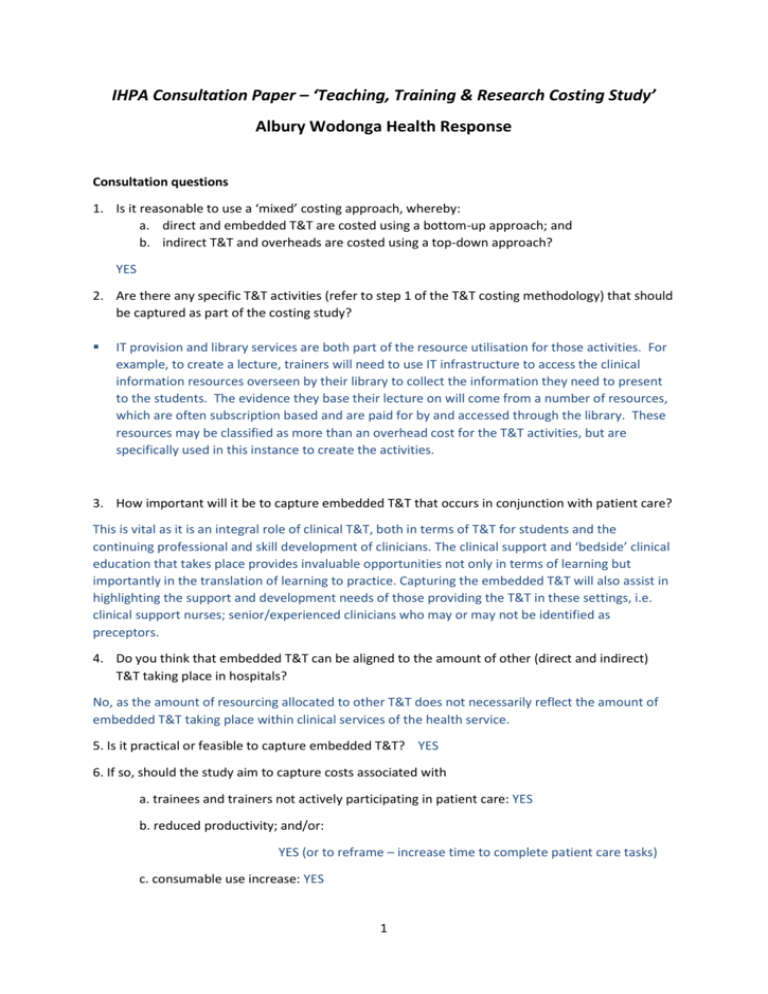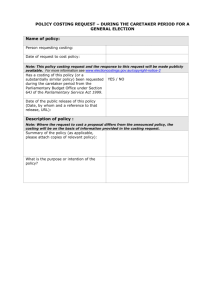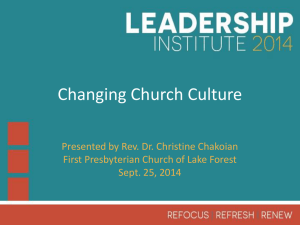albury_wodonga_health-vic
advertisement

IHPA Consultation Paper – ‘Teaching, Training & Research Costing Study’ Albury Wodonga Health Response Consultation questions 1. Is it reasonable to use a ‘mixed’ costing approach, whereby: a. direct and embedded T&T are costed using a bottom-up approach; and b. indirect T&T and overheads are costed using a top-down approach? YES 2. Are there any specific T&T activities (refer to step 1 of the T&T costing methodology) that should be captured as part of the costing study? IT provision and library services are both part of the resource utilisation for those activities. For example, to create a lecture, trainers will need to use IT infrastructure to access the clinical information resources overseen by their library to collect the information they need to present to the students. The evidence they base their lecture on will come from a number of resources, which are often subscription based and are paid for by and accessed through the library. These resources may be classified as more than an overhead cost for the T&T activities, but are specifically used in this instance to create the activities. 3. How important will it be to capture embedded T&T that occurs in conjunction with patient care? This is vital as it is an integral role of clinical T&T, both in terms of T&T for students and the continuing professional and skill development of clinicians. The clinical support and ‘bedside’ clinical education that takes place provides invaluable opportunities not only in terms of learning but importantly in the translation of learning to practice. Capturing the embedded T&T will also assist in highlighting the support and development needs of those providing the T&T in these settings, i.e. clinical support nurses; senior/experienced clinicians who may or may not be identified as preceptors. 4. Do you think that embedded T&T can be aligned to the amount of other (direct and indirect) T&T taking place in hospitals? No, as the amount of resourcing allocated to other T&T does not necessarily reflect the amount of embedded T&T taking place within clinical services of the health service. 5. Is it practical or feasible to capture embedded T&T? YES 6. If so, should the study aim to capture costs associated with a. trainees and trainers not actively participating in patient care: YES b. reduced productivity; and/or: YES (or to reframe – increase time to complete patient care tasks) c. consumable use increase: YES 1 7. How might embedded T&T be captured in a way that is robust, delineates T&T from patient care and also minimises impost on clinicians, trainees and health services? Observational measures (as per p.17) across a range of settings will be important – i.e. data needs to be collected not only large metropolitan hospitals but also in regional and rural settings. 8. Are there any other important considerations that should be taken into account when deciding whether embedded T&T should be in-scope for data collection? Rather than measuring based on the trainees and trainers not actively participating in patient care, rather focus on the observable transfer of knowledge taking place or facilitation of learning, i.e. the trainer actively asking the trainee to explain their understanding, discuss the patient care that they are involved in and rationale, reflect on their learning. The facilitated learning through questions (i.e. socratic questioning) to encourage the trainee/learner to discover learning for themselves is integral to a facilitative rather than didactic/direct approach and enables translation of learning to practice. 9. Are there any specific research products (refer to step 1 of the research costing methodology) that should be captured as part of this costing study? To support research capability within the organisation, the resources the organisation utilises to create the products will include library services and clinical information resources. For example, a literature search for evidence-based material to support a grant application will involve creating a search strategy, choosing resources to search, searching and selection of material, and acquisition of the full text items. In many cases, these tasks would involve the time and assistance of library services staff. Direct costs such as inter-library loan charges for full text material would also be applicable. An increase in an organisation’s research capability requires the library to provide increased library services to those staff and to have access to a larger range of resources, all costs that are specific to the products of the research capability rather than a general cost to the whole organisation. Library services are an explicit cost for a number of T&T and research products, and should be captured in the costing study. The cost associated with supporting staff in research skill development The cost associated with networking to develop research collaborations and support research capacity building within organisations should be included The cost in terms of time of co-supervisors of Higher Degree Research students who are employed by the health service (noting value of such research to the health service, particularly research which can inform practice and health service delivery). Research Governance costs (i.e. time required from administration support staff and decision makers) 10. Is there any data that should be collected, which does not appear in Appendix B? Nursing and midwifery: o Staff from other agencies attending for clinical experience, i.e. medics from Australian Defence Force (ADF); training staff from ADF; clinicians from small rural health services seeking access to higher acuity settings in regional services to maintain clinical skill sets. Allied Health: 2 o Staff from other agencies attending for clinical experience, i.e. clinicians from small rural health services seeking access to higher acuity settings in regional services to maintain clinical skill sets; academics from Education Providers seeking to maintain currency of practice; Has preparation time for trainers been included? Has the following been included: trainer/administration staff time been included in the coordination of registrations for training events, booking of venues; collating of and recording of attendances in health service training records central repository; and collation and review evaluation feedback? B.3 - Embedded T&T: There is a large amount of T&T time spent while delivering patient care. This may increase the amount of time the task takes. This needs to be included rather than only focusing on T&T taking place while ‘not delivering patient care’. B.4 – Research capability: In regional health services these roles / responsibilities may be undertaken by staff who would not be included in classifications such as ‘research department or research directorate’. A broader definition is needed to capture those positions which include research capability responsibilities, including research capacity building and research governance. B.5 – Outputs of research endeavour: o Number of practice/policy documents informed by locally conducted research o Number of staff providing consultation / supervision in the development of locally conducted research including co-supervisors. o Number of Honours students conducting research within the health service. 11. Are there any data items listed in Appendix B that you believe are unnecessary? No 12. What systems exist (for example, within health services, jurisdictional health departments or peak bodies) that can provide the data items in Appendix B? Clinical Placement Records Staff Registers / Personnel Records Human Resources Department / Payroll systems Clinical Education calendars / schedules Financial records – budget items Research Register Complied by: Debbie Stockton Manager Professional Development & Research Albury Wodonga Health Email: Debbie.Stockton@awh.org.au Phone: 02 6051 7435 3 4







